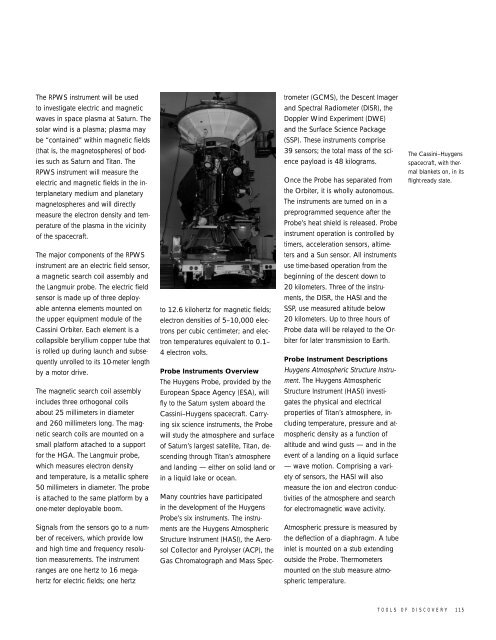Passage to a Ringed World - NASA's History Office
Passage to a Ringed World - NASA's History Office
Passage to a Ringed World - NASA's History Office
Create successful ePaper yourself
Turn your PDF publications into a flip-book with our unique Google optimized e-Paper software.
The RPWS instrument will be used<br />
<strong>to</strong> investigate electric and magnetic<br />
waves in space plasma at Saturn. The<br />
solar wind is a plasma; plasma may<br />
be “contained” within magnetic fields<br />
(that is, the magne<strong>to</strong>spheres) of bodies<br />
such as Saturn and Titan. The<br />
RPWS instrument will measure the<br />
electric and magnetic fields in the interplanetary<br />
medium and planetary<br />
magne<strong>to</strong>spheres and will directly<br />
measure the electron density and temperature<br />
of the plasma in the vicinity<br />
of the spacecraft.<br />
The major components of the RPWS<br />
instrument are an electric field sensor,<br />
a magnetic search coil assembly and<br />
the Langmuir probe. The electric field<br />
sensor is made up of three deployable<br />
antenna elements mounted on<br />
the upper equipment module of the<br />
Cassini Orbiter. Each element is a<br />
collapsible beryllium copper tube that<br />
is rolled up during launch and subsequently<br />
unrolled <strong>to</strong> its 10-meter length<br />
by a mo<strong>to</strong>r drive.<br />
The magnetic search coil assembly<br />
includes three orthogonal coils<br />
about 25 millimeters in diameter<br />
and 260 millimeters long. The magnetic<br />
search coils are mounted on a<br />
small platform attached <strong>to</strong> a support<br />
for the HGA. The Langmuir probe,<br />
which measures electron density<br />
and temperature, is a metallic sphere<br />
50 millimeters in diameter. The probe<br />
is attached <strong>to</strong> the same platform by a<br />
one-meter deployable boom.<br />
Signals from the sensors go <strong>to</strong> a number<br />
of receivers, which provide low<br />
and high time and frequency resolution<br />
measurements. The instrument<br />
ranges are one hertz <strong>to</strong> 16 megahertz<br />
for electric fields; one hertz<br />
<strong>to</strong> 12.6 kilohertz for magnetic fields;<br />
electron densities of 5–10,000 electrons<br />
per cubic centimeter; and electron<br />
temperatures equivalent <strong>to</strong> 0.1–<br />
4 electron volts.<br />
Probe Instruments Overview<br />
The Huygens Probe, provided by the<br />
European Space Agency (ESA), will<br />
fly <strong>to</strong> the Saturn system aboard the<br />
Cassini–Huygens spacecraft. Carrying<br />
six science instruments, the Probe<br />
will study the atmosphere and surface<br />
of Saturn’s largest satellite, Titan, descending<br />
through Titan’s atmosphere<br />
and landing — either on solid land or<br />
in a liquid lake or ocean.<br />
Many countries have participated<br />
in the development of the Huygens<br />
Probe’s six instruments. The instruments<br />
are the Huygens Atmospheric<br />
Structure Instrument (HASI), the Aerosol<br />
Collec<strong>to</strong>r and Pyrolyser (ACP), the<br />
Gas Chroma<strong>to</strong>graph and Mass Spec-<br />
trometer (GCMS), the Descent Imager<br />
and Spectral Radiometer (DISR), the<br />
Doppler Wind Experiment (DWE)<br />
and the Surface Science Package<br />
(SSP). These instruments comprise<br />
39 sensors; the <strong>to</strong>tal mass of the science<br />
payload is 48 kilograms.<br />
Once the Probe has separated from<br />
the Orbiter, it is wholly au<strong>to</strong>nomous.<br />
The instruments are turned on in a<br />
preprogrammed sequence after the<br />
Probe’s heat shield is released. Probe<br />
instrument operation is controlled by<br />
timers, acceleration sensors, altimeters<br />
and a Sun sensor. All instruments<br />
use time-based operation from the<br />
beginning of the descent down <strong>to</strong><br />
20 kilometers. Three of the instruments,<br />
the DISR, the HASI and the<br />
SSP, use measured altitude below<br />
20 kilometers. Up <strong>to</strong> three hours of<br />
Probe data will be relayed <strong>to</strong> the Orbiter<br />
for later transmission <strong>to</strong> Earth.<br />
Probe Instrument Descriptions<br />
Huygens Atmospheric Structure Instrument.<br />
The Huygens Atmospheric<br />
Structure Instrument (HASI) investigates<br />
the physical and electrical<br />
properties of Titan’s atmosphere, including<br />
temperature, pressure and atmospheric<br />
density as a function of<br />
altitude and wind gusts — and in the<br />
event of a landing on a liquid surface<br />
— wave motion. Comprising a variety<br />
of sensors, the HASI will also<br />
measure the ion and electron conductivities<br />
of the atmosphere and search<br />
for electromagnetic wave activity.<br />
Atmospheric pressure is measured by<br />
the deflection of a diaphragm. A tube<br />
inlet is mounted on a stub extending<br />
outside the Probe. Thermometers<br />
mounted on the stub measure atmospheric<br />
temperature.<br />
The Cassini–Huygens<br />
spacecraft, with thermal<br />
blankets on, in its<br />
flight-ready state.<br />
TOOLS OF DISCOVERY 115
















